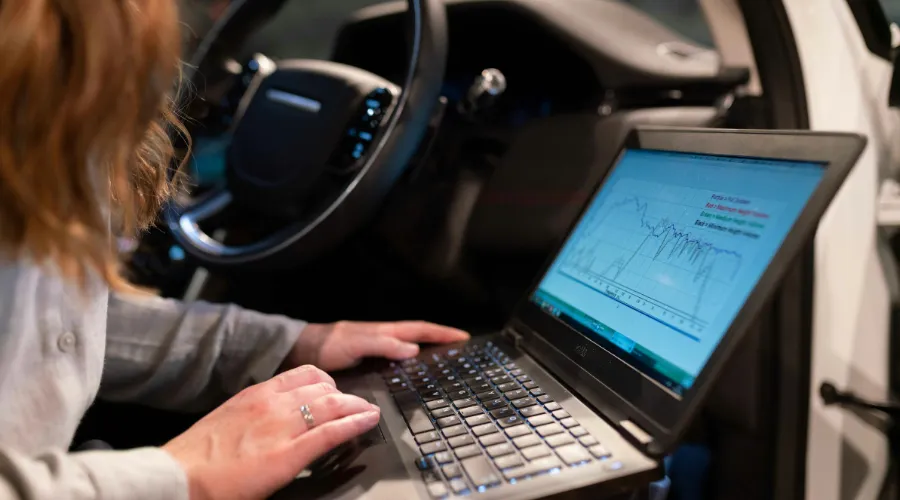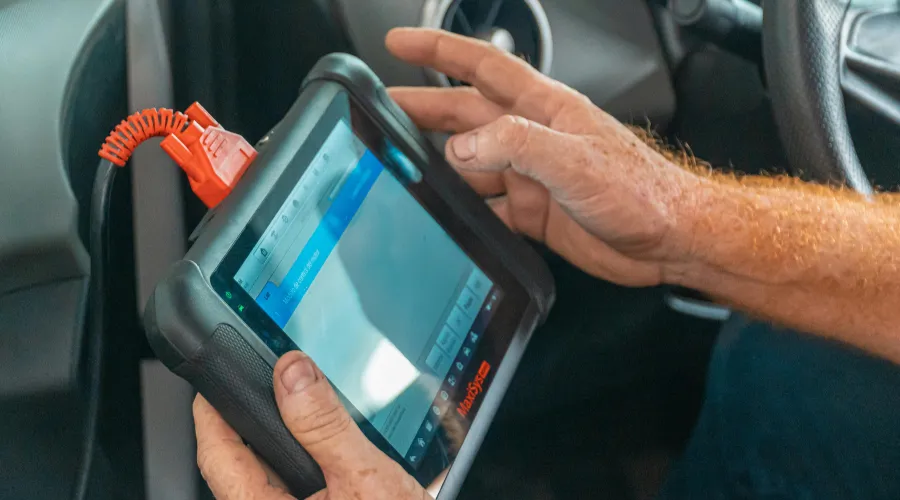Onboard Diagnostic Systems: How to Monitor Your Car’s Health

Anúncios
Onboard diagnostic systems are the unsung heroes of modern vehicles, quietly working to keep your car running smoothly while alerting you to potential issues.
These sophisticated networks of sensors and software act like a doctor for your vehicle, diagnosing problems before they escalate into costly repairs.
In 2025, with cars becoming smarter and more connected, understanding how these systems work is no longer just for mechanics—it’s essential for every driver who wants to stay ahead of the curve.
Anúncios
This article dives deep into the world of onboard diagnostic systems, exploring their evolution, functionality, and why they’re critical for maintaining your car’s health.
Buckle up as we unpack the tech, share practical insights, and empower you to take control of your vehicle’s well-being.
As technology continues to advance, the importance of onboard diagnostic systems will only increase.
Drivers who familiarize themselves with these systems will be better equipped to manage their vehicle’s performance and longevity.
The Evolution of Car Diagnostics
Imagine your car as a living organism, with onboard diagnostic systems serving as its nervous system, constantly monitoring vital signs.
The journey of these systems began in the 1980s with the introduction of OBD-I, a rudimentary setup designed to monitor basic emissions-related components.
By the mid-1990s, OBD-II emerged as a standardized, mandatory system in the United States, revolutionizing how vehicles communicate issues.
Today, in 2025, we’re seeing advanced iterations that integrate with cloud-based platforms and AI-driven analytics, offering real-time insights into everything from engine performance to tire pressure.
The leap from OBD-I to OBD-II was monumental, but the latest advancements are even more impressive.
Modern onboard diagnostic systems leverage machine learning to predict potential failures before they occur.
For instance, a 2023 study by the Society of Automotive Engineers found that predictive diagnostics reduced unexpected breakdowns by 27% in connected vehicles.
This isn’t just about convenience—it’s about safety, efficiency, and saving money.
As cars become more like rolling computers, these systems are evolving to keep pace, making them indispensable for today’s drivers.
Additionally, the integration of cloud technology allows for continuous updates and improvements to diagnostic systems, enhancing their capabilities over time.
This evolution ensures that drivers are always equipped with the latest tools for monitoring their vehicle’s health.
How Onboard Diagnostic Systems Work
At their core, onboard diagnostic systems are a network of sensors, actuators, and an electronic control unit (ECU) that communicate to monitor a vehicle’s performance.
When you start your car, the ECU begins collecting data from dozens of sensors tracking metrics like oxygen levels, fuel efficiency, and transmission behavior.
If something’s off—say, a misfiring spark plug—the system generates a diagnostic trouble code (DTC) that pinpoints the issue.
Think of it like your car sending you a text message saying, “Hey, my left lung’s acting up!”
This process isn’t just reactive; it’s proactive.
Advanced systems now use real-time data to optimize performance, adjusting fuel injection or timing to improve efficiency.
For example, consider Sarah, a commuter in Chicago who noticed her car’s fuel economy dropping.
Using an OBD-II scanner, she discovered a faulty oxygen sensor, replaced it for $150, and saved hundreds in fuel costs over the year.
Without onboard diagnostic systems, she might have ignored the issue until it caused a cascade of engine problems.
This is the power of real-time monitoring—it empowers drivers to act before small issues become big ones.
| Component | Function | Common Issues Detected |
|---|---|---|
| Oxygen Sensor | Measures air-fuel ratio | Poor fuel economy, emissions spikes |
| Mass Airflow Sensor | Monitors air intake | Engine misfires, rough idling |
| ECU | Processes sensor data | Software glitches, code errors |
Moreover, understanding how these systems detect issues can help drivers make informed decisions about repairs and maintenance.
This knowledge can lead to better vehicle care and potentially lower repair costs.
+ Driver Fatigue Monitoring Systems: Technology That Saves Lives
Why Monitoring Your Car’s Health Matters
Ever wonder why some cars seem to run forever while others break down prematurely?
The answer often lies in proactive maintenance, and onboard diagnostic systems are your first line of defense.
These systems don’t just catch problems—they help you understand your vehicle’s overall health.
By regularly scanning for DTCs, you can address minor issues like a clogged air filter before they lead to catastrophic failures like a blown head gasket.
Beyond repairs, these systems contribute to environmental sustainability.
A malfunctioning catalytic converter, for instance, can increase emissions by up to 40%, according to the Environmental Protection Agency.
By catching such issues early, onboard diagnostic systems help reduce your carbon footprint.
Plus, with fuel prices hovering around $3.50 per gallon in 2025, optimizing performance through diagnostics can save you significant cash at the pump.
Ignoring these insights is like ignoring a fever—you might feel fine for a while, but the underlying issue won’t go away.
Additionally, keeping an eye on your car’s health can extend its lifespan, ensuring that you get the most value out of your investment.
Regular monitoring can lead to better resale value when it’s time to upgrade.

Tools to Tap Into Onboard Diagnostic Systems
Accessing the power of onboard diagnostic systems doesn’t require a mechanic’s toolbox.
The rise of consumer-friendly OBD-II scanners has democratized car diagnostics.
Devices like the BlueDriver or FIXD plug into your car’s OBD-II port (usually under the dashboard) and connect to your smartphone via Bluetooth, translating complex codes into plain English.
For example, John, a rideshare driver in Austin, uses a $50 scanner to monitor his vehicle’s health between shifts.
When his check engine light came on, the scanner revealed a loose gas cap—fixed in seconds, no mechanic needed.
For those who want deeper insights, advanced tools like CarMD or professional-grade scanners offer detailed reports and predictive analytics.
Some modern vehicles even integrate diagnostics into infotainment systems, displaying alerts directly on your dashboard.
Whether you’re a DIY enthusiast or just want peace of mind, these tools make it easy to stay informed.
The table below compares popular OBD-II scanners to help you choose the right one.
| Scanner | Price Range | Key Features | Best For |
|---|---|---|---|
| BlueDriver | $100-$120 | Bluetooth, detailed reports | DIY enthusiasts |
| FIXD | $50-$70 | User-friendly app, real-time alerts | Casual drivers |
| CarMD | $80-$100 | Comprehensive diagnostics, repair cost estimates | Budget-conscious mechanics |
You can also find more information about OBD-II scanners and their features at OBD-Codes.
This website offers resources and reviews that can help you make an informed choice.
The Role of Connectivity in Modern Diagnostics
The era of connected cars has supercharged onboard diagnostic systems.
In 2025, many vehicles come equipped with telematics systems that transmit diagnostic data to manufacturers or third-party apps in real time.
This connectivity allows for over-the-air updates to fix software glitches or optimize performance without a trip to the shop.
For instance, Tesla’s vehicles use cloud-based diagnostics to predict battery degradation, alerting drivers to potential issues months in advance.
This shift also opens the door to subscription-based diagnostic services.
Companies like GM and Ford offer apps that provide detailed health reports, maintenance reminders, and even remote diagnostics.
While these services often come with a monthly fee, they offer unparalleled convenience.
However, there’s a flip side: data privacy.
With cars collecting vast amounts of data, drivers must be vigilant about who accesses their vehicle’s information.
Are you comfortable sharing your car’s data with manufacturers, or do you prefer a standalone scanner for privacy?
It’s a question worth pondering as connectivity reshapes diagnostics.
Furthermore, the ability to receive real-time updates and alerts can significantly enhance the driving experience, providing peace of mind for drivers.
This connectivity also allows for better customer service from manufacturers, as they can proactively address issues.

Practical Tips for Using Onboard Diagnostic Systems
Ready to take charge of your car’s health?
Start by investing in a reliable OBD-II scanner—most cost under $100 and pay for themselves quickly.
Check your vehicle’s OBD-II port regularly, especially if the check engine light appears.
Apps like Torque Pro or OBD Auto Doctor can enhance your scanner’s functionality, offering graphs and historical data to track trends.
For example, monitoring fuel trim levels can reveal inefficiencies long before a warning light appears.
Don’t ignore minor codes.
A P0420 code (catalytic converter issue) might seem harmless, but delaying repairs can lead to thousands in damage.
Schedule scans monthly, especially if you drive in harsh conditions like extreme heat or heavy traffic.
Finally, keep your car’s software updated.
Manufacturers often release patches to improve diagnostic accuracy, much like updating your smartphone.
By staying proactive, you’re not just maintaining your car—you’re extending its lifespan.
Additionally, creating a routine for checking your vehicle’s diagnostics can help you catch issues early, preventing costly repairs down the line.
This habit can lead to a more reliable and enjoyable driving experience.
++ Stability Control Systems: How They Improve Safety
The Future of Onboard Diagnostic Systems
The road ahead for onboard diagnostic systems is exhilarating.
With the rise of electric vehicles (EVs) and autonomous driving, diagnostics are becoming more sophisticated.
EVs rely heavily on battery management systems, which use advanced diagnostics to monitor cell health and charging efficiency.
Meanwhile, AI-driven systems are being developed to predict failures with pinpoint accuracy, potentially reducing repair costs by billions annually.
By 2030, experts predict that 80% of new vehicles will feature fully integrated, cloud-based diagnostic platforms.
Yet, challenges remain.
The right-to-repair movement is pushing back against manufacturers locking diagnostic data behind paywalls, arguing that drivers deserve full access to their vehicle’s information.
As onboard diagnostic systems evolve, balancing innovation with accessibility will be key.
The future promises smarter, more intuitive diagnostics, but it’s up to drivers to demand transparency and control.
Moreover, as technology continues to advance, we can expect even more integration between vehicles and smart technologies, making diagnostics an integral part of everyday driving.
This integration will further enhance the user experience and vehicle performance.
Why You Can’t Afford to Ignore Diagnostics
Your car is more than a mode of transport—it’s an investment.
Onboard diagnostic systems give you the tools to protect that investment, offering insights that save time, money, and stress.
From catching a faulty sensor to optimizing fuel efficiency, these systems are your co-pilot in the journey of car ownership.
Ignoring them is like driving blindfolded: you might get lucky for a while, but the risks are too high.
By embracing onboard diagnostic systems, you’re not just reacting to problems—you’re preventing them.
Whether you’re a daily commuter or a weekend road-tripper, these systems empower you to drive smarter, safer, and greener.
So, grab a scanner, plug into your car’s brain, and start listening to what it’s telling you.
Your wallet, your safety, and the planet will thank you.
Additionally, staying informed and proactive about your vehicle’s diagnostics can enhance your overall driving experience, making it more enjoyable and worry-free.
Taking charge of your car’s health is an investment in both your safety and your financial well-being.
